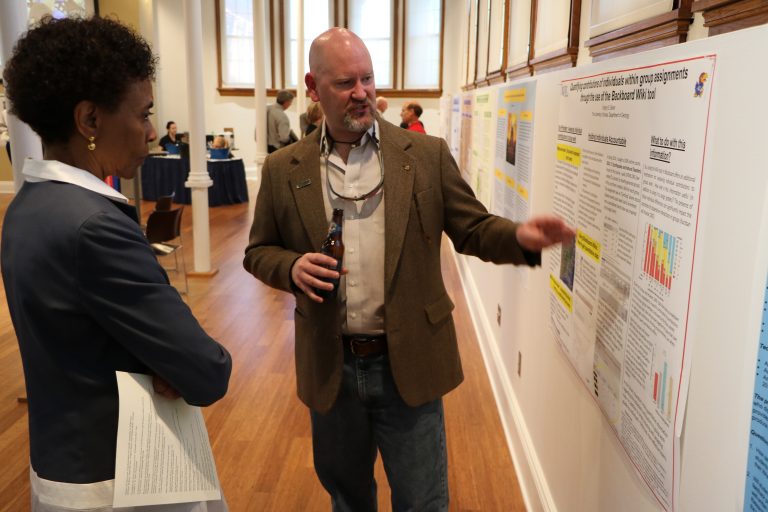The future of teaching went on display Friday afternoon in Spooner Hall.
By display, I mean the 30-plus posters that hung from the walls of The Commons, documenting the changes that KU faculty members and post-doctoral teaching fellows made to courses this academic year.

The poster session was the culmination of this year’s C21 Course Redesign Consortium(There was a link but the page no longer exists), but it included work from participants in last year’s Best Practices Institute(There was a link but the page no longer exists) and those involved in a project known as Trestle, which is funded with a grant from the National Science Foundation.
Most of the posters explained efforts to incorporate active learning into classes.
Abbey Dvorak, an assistant professor of music therapy, captured the spirit of the poster session with a question she used to guide her course redesign:
“How am I going to get students to engage with this material, learn, and then demonstrate their learning?”
That’s a simple question, but don’t let it fool you. It can be difficult to answer. Most of us who teach struggle with that question semester to semester. The faculty members and teaching fellows at the poster session offered bursts of inspiration in their work, though, demonstrating how they have approached various problems in teaching and learning. For instance:
- Stefanie DeVito, Brad Williamson, and Trevor Rivers explained how making an introductory biology course more student-centered improved students’ attitudes toward biology.
- Jennifer Roberts, Noah McLean, Greg Baker, and Andreas Moller explained how shifting an introductory geology course to an active learning model improved student grades, reduced the percentage of students who failed or withdrew, and greatly reduced performance gaps between men and women.
- The Department of Speech-Language-Hearing explained how a series of faculty workshops helped it increase the number of online learning modules.
- Susan Marshall from psychology explained her efforts to use a pre-class survey to better prepare students for an online course.
Not every poster showed success, but then success wasn’t the point. The point was to show how reflective teaching can lead to important changes in teaching and learning. (You’ll find more than 100 other examples at CTE’s online portfolio gallery(There was a link but the page no longer exists).)
I called this session the future of teaching for three reasons:
- It shows how instructors are using engaged and active learning, and evidence-based teaching practices to improve student learning.
- It shows how important reflection is in the teaching process.
- It shows how building community around innovative, reflective teaching can provide support for faculty in a broad range of disciplines.
Teaching rarely gets the attention it deserves, especially in the promotion and tenure process at research universities like KU. That simply must change. Students and parents are demanding more from their education. Society is demanding evidence that higher education does what it says it does. And those of us in the academy must provide better explanations.
Groups like C21 help bridge the gap between research and teaching. The future involves better teaching, better documentation, and constant revision in our courses. Those who participated in Friday’s poster session helped show us the way forward.
Check out some scenes of active learning at KU in this video, which we showed during the C21 poster session. (There’s no sound, just images.)
Doug Ward is the associate director of the Center for Teaching Excellence and an associate professor of journalism. You can follow him on Twitter @kuediting.
Tagged active learning, future of higher education, reflective teaching, student learning, C21